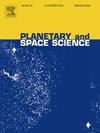Absolute photometry of small main-belt binary asteroids. Physical properties
IF 1.7
4区 物理与天体物理
Q3 ASTRONOMY & ASTROPHYSICS
引用次数: 0
Abstract
Here we present the physical characteristics of 24 discovered and 2 probable small binary asteroids at the inner main belt based on photometric lightcurves of the primary components of these systems obtained in the standard VR spectral bands, as well as the determination of the V–R color indices and the absolute magnitudes HV of the studied objects. We also make estimates of the effective diameters of six asteroids which radiometric data are not available.
Analysis of the V–R color indices, revised albedo, color indices obtained from the SDSS and Sky-Mapper surveys, as well as recently published spectral characteristics in the visible and infrared wavelength ranges, allows us to effectively make a taxonomy of the observed asteroids. We have determined that the most of these primary components of the main-belt small binary asteroids belong to the moderate-albedo S-type with the mean albedo 0.24 ± 0.08. Also, there are moderate-albedo asteroids of the A, M, Q, and V-types as well as high-albedo E-type in our sample. It should be noted that asteroids with low albedo are absent in our set of binary asteroids.
小型主带双星小行星的绝对光度测定。物理性质
本文根据在标准VR光谱波段中获得的24颗已发现的和2颗可能的小型双星小行星的光度光曲线,以及所研究天体的V-R显色指数和绝对星等HV的测定,给出了它们在内主带的物理特征。我们还估计了六颗没有辐射测量数据的小行星的有效直径。分析V-R色指数、修正反照率、从SDSS和Sky-Mapper调查中获得的色指数,以及最近公布的可见光和红外波长范围内的光谱特征,使我们能够有效地对观测到的小行星进行分类。我们确定了这些主带小双小行星的主要成分大部分属于中等反照率s型,平均反照率为0.24±0.08。此外,我们的样本中还有A、M、Q和v型的中等反照率小行星以及高反照率的e型小行星。值得注意的是,低反照率的小行星在我们的双星小行星组中是不存在的。
本文章由计算机程序翻译,如有差异,请以英文原文为准。
求助全文
约1分钟内获得全文
求助全文
来源期刊

Planetary and Space Science
地学天文-天文与天体物理
CiteScore
5.40
自引率
4.20%
发文量
126
审稿时长
15 weeks
期刊介绍:
Planetary and Space Science publishes original articles as well as short communications (letters). Ground-based and space-borne instrumentation and laboratory simulation of solar system processes are included. The following fields of planetary and solar system research are covered:
• Celestial mechanics, including dynamical evolution of the solar system, gravitational captures and resonances, relativistic effects, tracking and dynamics
• Cosmochemistry and origin, including all aspects of the formation and initial physical and chemical evolution of the solar system
• Terrestrial planets and satellites, including the physics of the interiors, geology and morphology of the surfaces, tectonics, mineralogy and dating
• Outer planets and satellites, including formation and evolution, remote sensing at all wavelengths and in situ measurements
• Planetary atmospheres, including formation and evolution, circulation and meteorology, boundary layers, remote sensing and laboratory simulation
• Planetary magnetospheres and ionospheres, including origin of magnetic fields, magnetospheric plasma and radiation belts, and their interaction with the sun, the solar wind and satellites
• Small bodies, dust and rings, including asteroids, comets and zodiacal light and their interaction with the solar radiation and the solar wind
• Exobiology, including origin of life, detection of planetary ecosystems and pre-biological phenomena in the solar system and laboratory simulations
• Extrasolar systems, including the detection and/or the detectability of exoplanets and planetary systems, their formation and evolution, the physical and chemical properties of the exoplanets
• History of planetary and space research
 求助内容:
求助内容: 应助结果提醒方式:
应助结果提醒方式:


